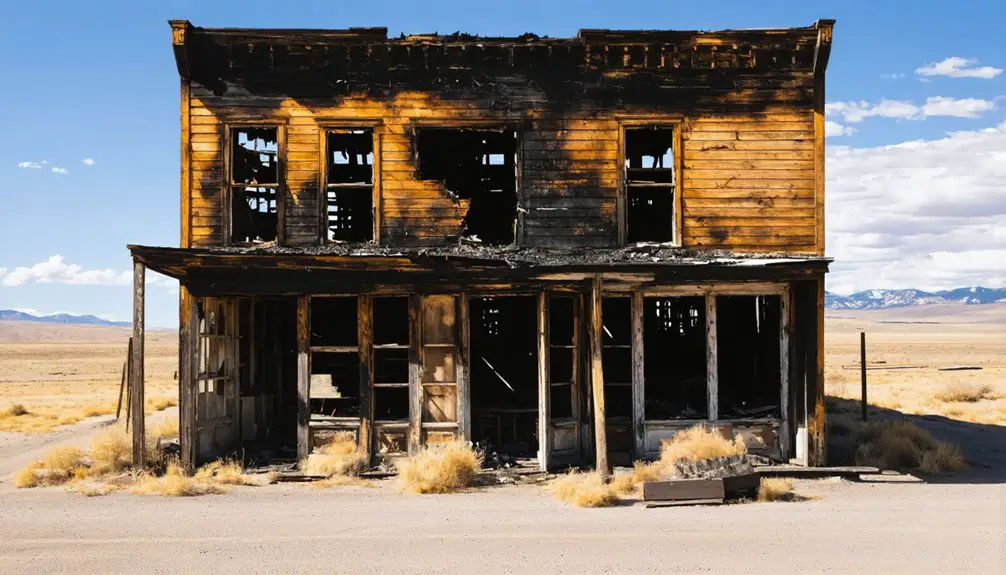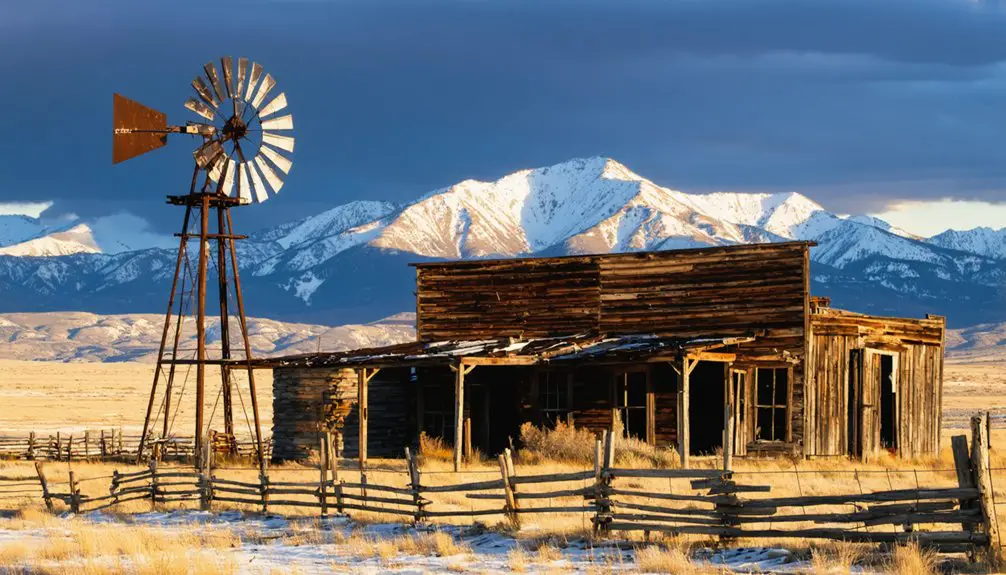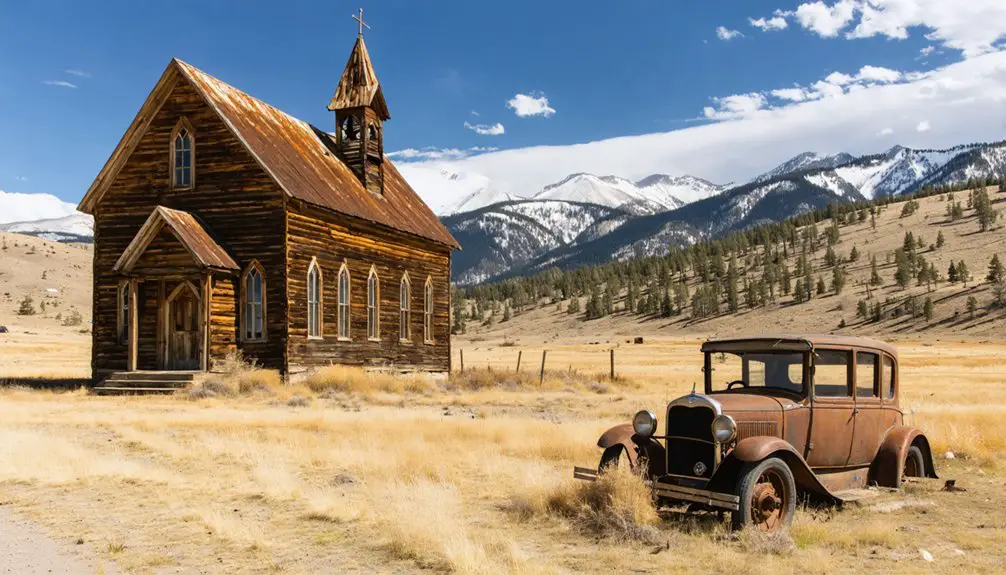You’ll find Alva’s remnants in Wyoming’s rolling prairies, where this former coal mining boomtown flourished in the late 19th century. The discovery of rich coal deposits transformed this remote settlement into a thriving community of 2,000 residents, complete with saloons, meat houses, and mining operations centered around the Central Pacific Mine. While devastating fires ultimately led to its decline, Alva’s archaeological treasures tell fascinating stories of Wyoming’s mining heritage.
Key Takeaways
- Alva originated as a coal mining settlement in late 19th century Wyoming, reaching its peak population of 2,000 residents in the 1860s.
- The discovery of three major gold deposits in 1890 transformed Alva into a booming mining town with extensive mining operations.
- Devastating fires, economic downturns, and subsequent job losses led to Alva’s eventual abandonment and transformation into a ghost town.
- The town featured essential structures including cabins, meat houses, saloons, and makeshift schoolhouses supporting a close-knit mining community.
- Located in the Bighorn Mountains at 4,000 feet elevation, the ghost town site contains prehistoric artifacts dating back 16,000 years.
The Birth of a Mining Frontier Settlement
While many Western frontier towns sprouted from gold and silver discoveries, Alva, Wyoming emerged in the late 19th century as a coal mining settlement near Evanston in Uinta County.
Unlike its precious metal counterparts, Alva arose from Wyoming’s rich coal deposits, becoming a vital 19th-century mining settlement.
Similar to how uranium market collapse devastated Jeffrey City, the mining economy in Alva was vulnerable to market fluctuations.
You’ll find that early mining techniques were basic but effective, with prospectors staking claims near rich coal seams they’d discovered during initial surveys. The settlement quickly attracted laborers and entrepreneurs who invested in wooden superstructures, headframes, and essential mining infrastructure.
The town’s community dynamics centered around the Central Pacific Mine, where workers and their families created a close-knit but transient society. Like many places with the Almy surname, the town’s name reflected the pioneering spirit of early settlers.
You’d have seen temporary housing camps and small supply stores pop up to serve daily needs, while the arrival of railroad connections helped establish Alva as a crucial hub for coal distribution to growing regional markets.
Peak Years and Population Boom
You’ll find Alva’s most prosperous period emerged in the late 1860s when the discovery of the Atlantic Lode sparked a rush that brought the population to roughly 2,000 residents.
The town’s rapid expansion created a bustling community filled with mining-related businesses, temporary housing, and the rough-and-tumble atmosphere typical of Western boomtowns. The area became part of the historic South Pass district, sharing many characteristics with nearby Atlantic City. Like many mining communities, the residents frequently moved between settlements in search of better mineral deposits.
During these peak years, Alva’s mining wealth attracted a diverse mix of miners, entrepreneurs, and their families, though census records from 1870 suggest some historical population estimates may have been inflated.
Rapid Growth and Development
During the late 1860s, Alva experienced an extraordinary population surge that transformed the fledgling settlement into a bustling mining town of up to 2,000 residents. You’d have witnessed rapid settlement patterns as miners and support workers flocked to the area, establishing a vibrant community along what’s now Wyoming Highway 24.
The town’s growth sparked quick development of essential community structures. You’d have found a mix of practical buildings, from basic cabins and meat houses to lively saloons where miners gathered after their shifts. Similar to Miner’s Delight, many of these buildings would become historical landmarks. For researchers seeking specific information, the town’s structures are listed in disambiguation pages to distinguish them from other historical Alva locations.
The strategic location made it easy to transport goods and people, while commercial establishments popped up to serve the swelling population. Multi-use buildings became centers of daily life, creating a self-sufficient hub that supported the mining-focused economy.
Mining Wealth Draws Thousands
Three massive gold discoveries in 1890 transformed Alva into a mining boomtown, drawing thousands of prospectors to the newly established Gold Hill mining camp.
You’d have witnessed a frenzy of activity as surface veins yielded extraordinary values up to $43,000 per ton, while mining technology advanced with the construction of stamp mills and sawmills to process the rich ore.
The railroad’s arrival made it easier for miners to flood in, bringing their families and dreams of striking it rich.
Despite occasional labor disputes, the Acme Consolidated Gold & Copper Mining Co. expanded operations rapidly, patenting hundreds of acres of claims.
Workers hastily constructed temporary housing and infrastructure to accommodate the surging population, though they couldn’t have known the boom wouldn’t last below 100 feet deep.
Unfortunately, the Mountain View Hotel was built during this period of mining promotional efforts, serving as a testament to the town’s fleeting prosperity.
Like South Pass City’s Carissa Mine in 1867, the gold rush fever brought an influx of eager prospectors hoping to strike it rich in Wyoming’s mineral-rich terrain.
Social Life During Prosperity
While miners toiled in Alva’s rich gold mines, a vibrant social scene emerged around the town’s multiple saloons, meat house, and seven family cabins.
You’d find community gatherings happening daily, from informal chats at the shops to organized events at the local church. Educational activities took place in makeshift schoolhouses where children learned basic literacy while their parents worked the mines.
The town’s central path made it easy to move between social hubs, where you could catch up on local news or join a card game at one of the saloons.
Religious services, seasonal festivals, and mining celebrations brought everyone together, creating a tight-knit community.
Despite the town’s modest size, you’d experience a rich social life balanced between work, worship, and leisure – all centered around the shared dream of striking it rich.
Daily Life in a Wyoming Boomtown
Life in Alva’s boomtown revolved around the demanding rhythms of industrial work, where daily wages of $3.50 shaped everything from housing to social activities.
You’d find yourself living in company-provided housing, with single men packed into bunkhouses while families occupied modest cottages. Oil production reached an astounding 35.3 million barrels in 1923. The community dynamics reflected the seasonal nature of mining work, forcing many to take on side jobs for survival. Workers faced harsh conditions with limited working days, sometimes operating only 90 days per year.
Your daily routines would’ve included:
- Walking everywhere since cars were scarce
- Eating at massive company dining halls where meals were deducted from your paycheck
- Making do with handcrafted furniture from shipping crates
During off-seasons, you’d join the cultural exchange at church gatherings or company clubhouses, while your kids might be attending the growing local schools.
Recreation meant embracing the outdoors – fishing, hunting, and camping at nearby reservoirs.
The Great Fire and Economic Decline

As devastating wildfires swept through Wyoming’s pine forests in the early 20th century, Alva faced its most formidable challenge yet.
Lightning strikes ignited fast-moving fires that jumped from treetop to treetop, creating spot fires miles ahead of the main blaze. You’d have witnessed firefighters struggling with basic tools like Pulaskis and shovels, ultimately overwhelmed by the fire’s ferocity.
Flames leaped through pine canopies as exhausted crews fought hopelessly with hand tools against nature’s unstoppable force.
The fire aftermath proved catastrophic for Alva’s economy.
You can still see evidence of how the destruction of timber resources crippled the logging industry, while damaged rail lines cut off crucial trade routes.
Economic recovery became impossible as investors fled and businesses shuttered.
With jobs vanishing and residents moving away, Alva’s transformation into a ghost town accelerated, marking the end of its prosperous era.
Archaeological Discoveries and Remnants
The archaeological riches of Alva tell a far deeper story than its ghost town remains. You’ll find prehistoric artifacts dating back an astounding 16,000 years, including unique projectile points that predate Clovis technology.
The area’s cultural practices reveal themselves through remnants of eagle traps, earth ovens, and the continent’s only known early red ochre mine.
Today’s archaeologists carefully protect these treasures through:
- GPS marking instead of physical flags to prevent looting
- Strategic excavation techniques to preserve undisturbed layers
- International collaboration to guarantee proper scientific study
You can spot ancient housepits and tool-making sites along the prehistoric terrace, while building foundations and a weathered cemetery mark the more recent ghost town era.
This remarkable site offers a continuous timeline of human presence in Wyoming’s rugged landscape.
Geographic Features and Natural Resources

You’ll find Alva’s terrain marked by rolling prairies at nearly 4,000 feet elevation, with limited water resources typical of Wyoming’s semi-arid environment.
Unlike neighboring ghost towns that boomed from mineral wealth, Alva’s surroundings offered modest natural resources, primarily supporting ranching and grazing activities.
The town’s position along Wyoming Highway 24 serves as the main access point today, though it never benefited from the railroad connections that sustained many other Wyoming settlements.
Mineral-Rich Mountain Terrain
Located within Wyoming’s dramatic Bighorn Mountains, Alva sits amid a complex geological landscape shaped by ancient mountain-building events spanning billions of years.
You’ll find yourself surrounded by mineral deposits formed during the Laramide Orogeny, when powerful tectonic forces thrust ancient Archean rocks upward through younger sedimentary layers.
The area’s distinctive geological formations include:
- Resistant Minnelusa Sandstone creating dramatic rock-bound gorges
- Paleozoic limestone cliffs of the Madison Group
- Exposed granite cores dating back 2.5-3 billion years
As you explore the terrain, you’ll notice the steep eastern flanks of the mountains contrast sharply with gentler western slopes.
These varying angles reveal the area’s intense tectonic history, while unstable rock layers continue to shape the landscape through occasional landslides and debris flows.
Local Water Sources
Water shaped early life around Alva through an intricate network of natural springs, groundwater aquifers, and the mighty North Platte River system.
You’ll find the area’s rich water sources stem from multiple geological formations, including the Alcova Limestone Member and Tensleep Sandstone, where aquifer recharge occurs through precipitation and surface water infiltration.
Before Alcova Dam‘s completion in 1937, you could’ve witnessed the therapeutic hot springs that drew early settlers to this rugged landscape.
The dam’s construction submerged these original springs, transforming the region’s water features into today’s reservoir.
The water quality varies throughout the local aquifers, with dissolved solids telling the story of the water’s journey through ancient rock formations.
The North Platte still carves its path through the striking canyon walls, a reflection of nature’s persistent force.
Railroad Access Points
When the Union Pacific Railroad carved its path through southern Wyoming in 1868, the route’s success hinged on strategic access points shaped by the region’s dramatic landscape.
Railroad routes followed nature’s lead, utilizing water-rich corridors like Bitter Creek and the North Platte River to keep steam locomotives running. You’ll find the tracks winding through the lowest mountain passes and following natural basins, making the challenging terrain manageable for heavy freight.
- The line crossed the Laramie Range near Granite Canyon before skirting Elk Mountain’s northern slope.
- Tracks followed the natural low ridge north of Bridger Pass to enter the Great Divide Basin.
- The route utilized Weber Canyon to connect with the Great Salt Lake Basin, following established waterways.
Lasting Impact on Wyoming’s Mining Heritage
Through its tragic legacy of mining disasters and subsequent reforms, Almy left an indelible mark on Wyoming’s mining heritage. The 1881 explosion, which killed 38 miners and marked the first mine disaster west of the Mississippi, forced Wyoming to confront the dangers of unregulated mining.
You’ll find that the Almy disasters directly led to the creation of Wyoming’s state mining inspector office, revolutionizing safety standards across the territory.
While the mines closed in the 1940s, Almy’s impact endures. Today, you can explore the ghost town’s remnants, which serve as a powerful reminder of the human cost of western expansion.
The site continues to educate visitors about Wyoming’s industrial past and the critical importance of worker safety regulations that protect modern miners.
Frequently Asked Questions
Are There Any Paranormal Activities Reported at the Alva Ghost Town Site?
You’d love to hear spooky tales of ghost sightings at haunted locations in Alva, but there’s no documented paranormal activity – though nearby Wyoming ghost towns sure have their share of spirits.
Can Visitors Legally Collect Artifacts Found at the Alva Site?
You can’t legally collect artifacts without proper permits due to strict legal regulations. For artifact preservation, all historical items must stay onsite – even surface finds are protected by law.
What Were the Specific Minerals Discovered in the Atlantic Lode?
Like buried treasure beneath Earth’s skin, you’ll find the Atlantic Lode’s mineral composition includes gold, silver, copper, platinum group elements (palladium and platinum), and cobalt from historic mining operations.
Are There Any Surviving Photographs of Alva During Its Peak Years?
You won’t find any confirmed surviving photographs of the town’s peak years. While historical documentation exists for nearby mining communities, there’s no known photographic evidence specifically showing this settlement.
Which Living Descendants of Original Alva Settlers Still Reside in Wyoming?
Like trying to catch whispers in the wind, you can’t pinpoint specific living descendants of Alva settlers today. Historical records and settler lineage trails have faded into Wyoming’s vast landscape.
References
- https://www.youtube.com/watch?v=ErvYfYCW0qk
- https://www.wyomingcarboncounty.com/blog/123-5-ghost-towns-to-explore
- https://sites.rootsweb.com/~wytttp/ghosttowns.htm
- https://travelwyoming.com/blog/stories/post/5-wyoming-ghost-towns-you-need-to-explore/
- https://wyomingalmanac.com/?p=1633
- https://en.wikipedia.org/wiki/Almy
- https://www.legendsofamerica.com/wy-minersdelight/
- https://wyomingwhispers.com/wyomings-ghost-towns/
- http://userpages.aug.com/bdobson/photos9.html
- https://en.wikipedia.org/wiki/Alva



